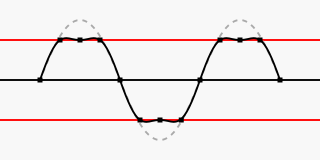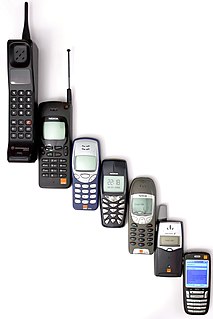The decibel is a unit of measurement used to express the ratio of one value of a power or field quantity to another on a logarithmic scale, the logarithmic quantity being called the power level or field level, respectively. It can be used to express a change in value or an absolute value. In the latter case, it expresses the ratio of a value to a fixed reference value; when used in this way, a suffix that indicates the reference value is often appended to the decibel symbol. For example, if the reference value is 1 volt, then the suffix is "V", and if the reference value is one milliwatt, then the suffix is "m".

In telecommunication and signal processing companding is a method of mitigating the detrimental effects of a channel with limited dynamic range. The name is a portmanteau of the words compressing and expanding. The use of companding allows signals with a large dynamic range to be transmitted over facilities that have a smaller dynamic range capability. Companding is employed in telephony and other audio applications such as professional wireless microphones and analog recording.

A weighting filter is used to emphasize or suppress some aspects of a phenomenon compared to others, for measurement or other purposes.
Dynamic range is the ratio between the largest and smallest values that a certain quantity can assume. It is often used in the context of signals, like sound and light. It is measured either as a ratio or as a base-10 (decibel) or base-2 logarithmic value of the difference between the smallest and largest signal values.

Sound quality is typically an assessment of the accuracy, enjoyability, or intelligibility of audio output from an electronic device. Quality can be measured objectively, such as when tools are used to gauge the accuracy with which the device reproduces an original sound; or it can be measured subjectively, such as when human listeners respond to the sound or gauge its perceived similarity to another sound.

In acoustics, loudness is the subjective perception of sound pressure. More formally, it is defined as, "That attribute of auditory sensation in terms of which sounds can be ordered on a scale extending from quiet to loud." The relation of physical attributes of sound to perceived loudness consists of physical, physiological and psychological components. The study of apparent loudness is included in the topic of psychoacoustics and employs methods of psychophysics.
Sound pressure or acoustic pressure is the local pressure deviation from the ambient atmospheric pressure, caused by a sound wave. In air, sound pressure can be measured using a microphone, and in water with a hydrophone. The SI unit of sound pressure is the pascal (Pa).
Sound power or acoustic power is the rate at which sound energy is emitted, reflected, transmitted or received, per unit time. The SI unit of sound power is the watt (W). It is the power of the sound force on a surface of the medium of propagation of the sound wave. For a sound source, unlike sound pressure, sound power is neither room-dependent nor distance-dependent. Sound pressure is a property of the field at a point in space, while sound power is a property of a sound source, equal to the total power emitted by that source in all directions. Sound power passing through an area is sometimes called sound flux or acoustic flux through that area.

An equal-loudness contour is a measure of sound pressure, over the frequency spectrum, for which a listener perceives a constant loudness when presented with pure steady tones. The unit of measurement for loudness levels is the phon, and is arrived at by reference to equal-loudness contours. By definition, two sine waves of differing frequencies are said to have equal-loudness level measured in phons if they are perceived as equally loud by the average young person without significant hearing impairment.
Sound energy density or sound density is the sound energy per unit volume. The SI unit of sound energy density is the pascal (Pa), that is the joule per cubic metre (J/m3) in SI based units.
A weighting curve is a graph of a set of factors, that are used to 'weight' measured values of a variable according to their importance in relation to some outcome. An important example is frequency weighting in sound level measurement where a specific set of weighting curves known as A, B, C and D weighting as defined in IEC 61672 are used. Unweighted measurements of sound pressure do not correspond to perceived loudness because the human ear is less sensitive at low and high frequencies, with the effect more pronounced at lower sound levels. The four curves are applied to the measured sound level, for example by the use of a weighting filter in a sound level meter, to arrive at readings of loudness in Phons or in decibels (dB) above the threshold of hearing..
In digital and analog audio, headroom refers to the amount by which the signal-handling capabilities of an audio system exceed a designated nominal level. Headroom can be thought of as a safety zone allowing transient audio peaks to exceed the nominal level without damaging the system or the audio signal, e.g., via clipping. Standards bodies differ in their recommendations for nominal level and headroom.

Decibels relative to full scale is a unit of measurement for amplitude levels in digital systems, such as pulse-code modulation (PCM), which have a defined maximum peak level. The unit is similar to the units dBov and dBO.

ITU-R 468 is a standard relating to noise measurement, widely used when measuring noise in audio systems. The standard, now referred to as ITU-R BS.468-4, defines a weighting filter curve, together with a quasi-peak rectifier having special characteristics as defined by specified tone-burst tests. It is currently maintained by the International Telecommunications Union who took it over from the CCIR.
Programme level refers to the signal level that an audio source is transmitted or recorded at, and is important in audio if listeners of Compact Discs (CDs), radio and television are to get the best experience, without excessive noise in quiet periods or distortion of loud sounds. Programme level is often measured using a peak programme meter or a VU meter.

A sound level meter is used for acoustic measurements. It is commonly a hand-held instrument with a microphone. The diaphragm of the microphone responds to changes in air pressure caused by sound waves. That is why the instrument is sometimes referred to as a Sound Pressure Level (SPL) Meter. This movement of the diaphragm, i.e. the sound pressure deviation, is converted into an electrical signal.

A-weighting is the most commonly used of a family of curves defined in the International standard IEC 61672:2003 and various national standards relating to the measurement of sound pressure level. A-weighting is applied to instrument-measured sound levels in an effort to account for the relative loudness perceived by the human ear, as the ear is less sensitive to low audio frequencies. It is employed by arithmetically adding a table of values, listed by octave or third-octave bands, to the measured sound pressure levels in dB. The resulting octave band measurements are usually added to provide a single A-weighted value describing the sound; the units are written as dB(A). Other weighting sets of values – B, C, D and now Z – are discussed below.
Loudness, K-weighted, relative to full scale (LKFS) is a loudness standard designed to enable normalization of audio levels for delivery of broadcast TV and other video. Loudness units relative to full scale (LUFS) is a synonym for LKFS that was introduced in EBU R128. Loudness units (LU) is an additional unit used in EBU R128. It describes Lk without direct absolute reference and therefore describes loudness level differences.








